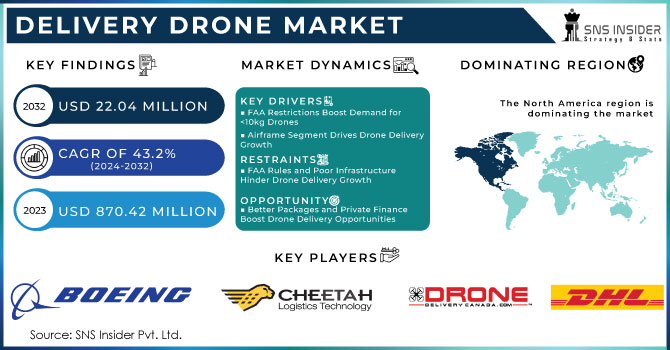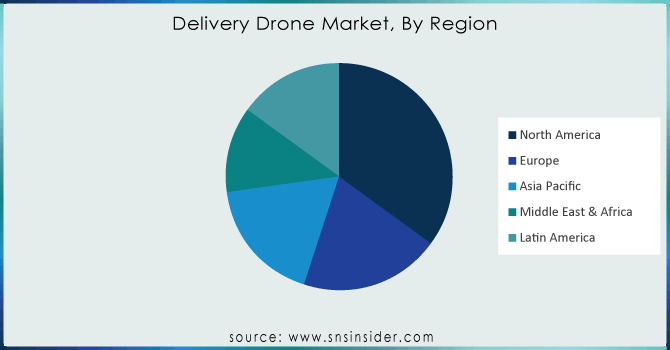Delivery Drone Market Report Scope & Overview:

To get more information on Delivery Drone Market - Request Free Sample Report
The Delivery Drone Market size was valued at US$ 870.42 million in 2023 and is estimated to reach US$ 22.04 billion by 2032 with a growing CAGR of 43.2% during the period 2024-2032.
The sudden rise of CAGR is due to the demand and growth of this market, returning to pre-epidemic levels once the epidemic is over.
Many transport and transportation companies are investing heavily in building a successful drone delivery infrastructure. Drone Delivery is a new mode of transportation for high-quality service providers and various commercial enterprises and medical facilities. Due to fast delivery time, high accuracy, and low human intervention in the supply chain, it has become the most sought-after method of the global supply of goods. Technology giants such as the United Parcel Service of America (UPS), Zipline, and the Deutsche Post DHL Group have established new commercial delivery platforms over the past few years.
For example, in March 2020, UPS partnered with Wingcopter to develop the next generation of cargo aircraft while adding new capabilities such as changing the VTDL aircraft with steady wings at high speeds, long distances, and high departure weight. These drones will be able to better operate in a variety of different utility industries.
KEY DRIVERS
The Federal Aviation Administration (FAA) has implemented strict restrictions on weight-bearing restrictions. Restricted the delivery of drones below 10kgs, which increased the demand for a portion of <10kg capacity in all regions. Therefore, a portion of the <10kg capacity is predicted to rise to a higher CAGR During the Drone Delivery Market Forecast.
The airframe segment enhances the growth of the Global Drone Delivery Market Market due to the growing research and development activities undertaken by various companies with improved features, reduced size, and higher durability.
Restraints
Operational challenges and new strict rules by the Federal Aviation Administration (FAA) place restrictions on the use of drones, which could affect global market growth. Another obstacle could be the complex area and poor infrastructure of Delivery Drone Market. Accordingly, Delivery Drone Market Growth may be disrupted due to the limited range of delivery drones (<10kg). Therefore, the global Delivery Drone market needs to guide drones delivered with the right information and the highest expertise.
OPPORTUNITIES
An increasing number of drones use better delivery packages are predicted to bring Drone Delivery Market Opportunities to various global market participants, such as drone service providers, drone manufacturers, software service providers, and drone infrastructure providers. Therefore, the growth of private finance in the drone industry brings many opportunities to the global market.
CHALLENGES
In commercial and public applications, operational safety is considered a major concern with the use of airborne drones. Thus, the increasing use of drones in commercial aviation and public programs has produced cases of drone hijacking incidents in various regions. Therefore, drug trafficking and data security breaches using airborne drones can be a major challenge for Delivery Drone Market.
THE IMPACT OF COVID-19
During the ongoing COVID epidemic, the world saw an increase in the distribution of the package without affecting in various ways, but drone delivery had an impact on the delivery and goods market. This development was due to disruptions in the provision of temporary supplies, which resulted in a high rate of drone delivery acceptance to combat weak growth in all areas such as local businesses, restaurants, diseases, medicine suppliers, and more. Also, the platform is widely used by law enforcement agencies, health care providers, commodity companies, service delivery forums, and e-commerce companies.
The epidemic provides a growing environment and time for commercial use of well-functioning and efficient drones. These items will provide lucrative opportunities for manufacturers, suppliers, service providers, and other companies operating in the market. The growing demand for uninterrupted delivery systems across all supply chains is expected to boost market growth during forecasting.
An ongoing epidemic came in 2020 with a temporary disruption. But it is considered a long-term structural change. It has affected many areas of marketing, but the introduction of new technologies and services has helped global products reach the entire e-commerce, medical, and other industries in a very long time.
Therefore, looking at the previous global Delivery Drone market effect shows that it faces short-term losses but predicts that it will meet the size of the Drone Delivery Market size in the coming years.
KEY MARKET SEGMENTATION
By Drone Type
-
Fixed Wing
-
Multi-rotor Wing
-
Hybrid Wing
By Component
-
Software
-
Hardware
-
Services
By Range
-
Less than or Equal to 25 Km
-
More than 25 Km
By Payload
-
Less than 2 Kg
-
2 Kg to 5 Kg
-
More than 5 Kg
By Duration
-
Less than 30 minutes
-
More than 30 minutes
By Operation Mode
-
Fully Autonomous
-
Partially Autonomous
-
Remotely Piloted
By Application
-
Retail & E-Commerce
-
Logistics & Transportation
-
Food & Beverages
-
Healthcare
-
Agriculture
-
Military & Defense
-
Others
REGIONAL ANALYSIS
The Global Delivery Drone Market is divided into various regions such as Asia-Pacific, Middle East & Africa, North America, Europe, and Latin America on a regional basis. Looking at the 2023 report, the North American region is expected to register hundred

Need any customization research on Delivery Drone Market - Enquiry Now
REGIONAL COVERAGE
North America
-
USA
-
Canada
-
Mexico
Europe
-
Germany
-
UK
-
France
-
Italy
-
Spain
-
The Netherlands
Rest of Europe
Asia-Pacific
-
Japan
-
South Korea
-
China
-
India
-
Australia
-
Rest of Asia-Pacific
The Middle East & Africa
-
Israel
-
UAE
-
South Africa
-
Rest of Middle East & Africa
Latin America
-
Brazil
-
Argentina
-
Rest of Latin America
Key Players
The Major Players are Boeing Company, Cheetah Logistics Technology, DHL International GmbH, Drone Delivery Canada Corp., Flirtey, FlyTrex, Wing Aviation LLC, Manna Aero, Airbus SA, Alibaba, Amazon and Other Players.
| Report Attributes | Details |
|---|---|
| Market Size in 2023 | US$ 870.42 Million |
| Market Size by 2032 | US$ 22.04 Billion |
| CAGR | CAGR of 43.2% From 2024 to 2032 |
| Base Year | 2023 |
| Forecast Period | 2024-2032 |
| Historical Data | 2020-2022 |
| Report Scope & Coverage | Market Size, Segments Analysis, Competitive Landscape, Regional Analysis, DROC & SWOT Analysis, Forecast Outlook |
| Key Segments | • By Drone Type (Fixed Wing, Multi-Rotor Wing, And Hybrid Wing) • By Component (Software, Hardware, And Services) • By Range (Less Than Or Equal To 25 Km And More Than 25 Km) • By Payload (Less Than 2 Kg, 2 Kg To 5 Kg, And More Than 5 Kg) • By Duration (Less Than 30 Minutes And More Than 30 Minutes) • By Operation Mode (Fully Autonomous, Partially Autonomous, And Remotely Piloted) • By Application (Retail & E-Commerce, Logistics & Transportation, Food & Beverages, Healthcare, Agriculture, Military & Defense, And Others) |
| Regional Analysis/Coverage | North America (USA, Canada, Mexico), Europe (Germany, UK, France, Italy, Spain, Netherlands, Rest of Europe), Asia-Pacific (Japan, South Korea, China, India, Australia, Rest of Asia-Pacific), The Middle East & Africa (Israel, UAE, South Africa, Rest of Middle East & Africa), Latin America (Brazil, Argentina, Rest of Latin America) |
| Company Profiles | The Boeing Company, Cheetah Logistics Technology, DHL International GmbH, Drone Delivery Canada Corp., Flirtey, FlyTrex, Wing Aviation LLC, Manna Aero, Airbus SA, Alibaba, Amazon. |
| Key Drivers | • The Federal Aviation Administration (FAA) has implemented strict restrictions on weight-bearing restrictions |
| RESTRAINTS | • Operational challenges and new strict rules by the Federal Aviation Administration (FAA) place restrictions on the use of drones, which could affect global market growth. |

